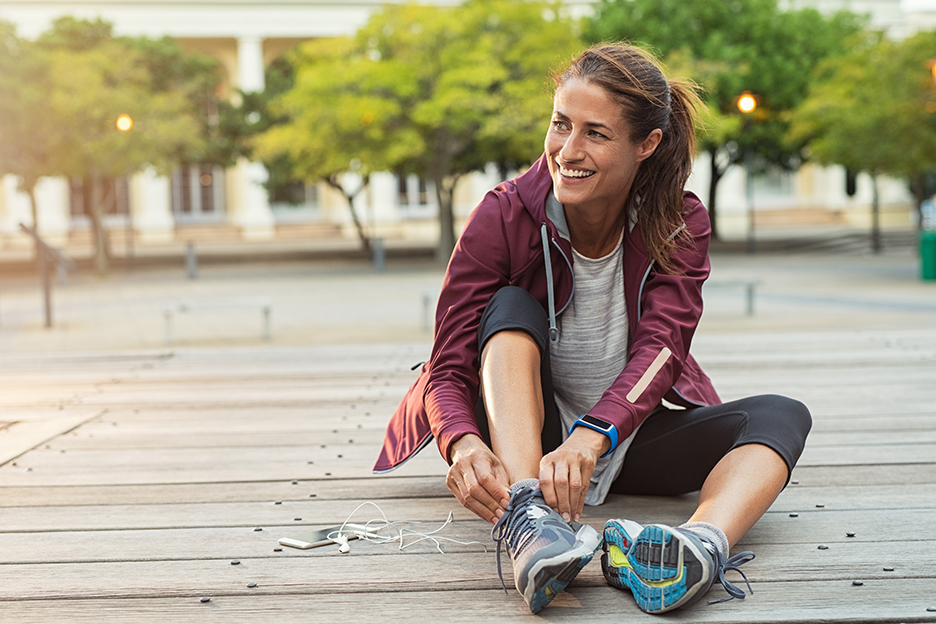You’ve decided this is the year you take on a sporting challenge. Whether your goal is to complete your first 5K run or finish a full marathon, the key remains the same: preparation. Here are some winning tips to help you cross the finish line without any injuries and with a smile on your face!

Equip yourself for success
Before you even start your first training session, you need to prepare properly and make sure you have the right gear and the right plan.
Pick your shoes with care
Whether you’ll be running on paved roads or on trails in the woods, you need the right pair of shoes for comfort and to prevent injuries. When shopping for shoes, consider the following two questions.
Question 1: does your foot have a high arch?
To answer these questions, simply stand on a piece of paper or cardboard with wet feet.
- If your footprint shows your heel, toes, and the outer side of your foot, your arch is normal.
- If your footprint shows your full foot, you probably have flat feet. That means your arch remains low to the ground. Your shoes will have to be designed with a low instep to support your feet without destabilizing them.
- If you only see your heel and the tip of your feet, your arch is high. This is also known as a cavus foot. You’ll need shoes with a high arch support to stabilize your feet.
Question 2: what type of stride do you have?
In other words, how do your feet hit the ground when you’re running?
- A neutral stride means your feet land on the ground relatively evenly – they don’t roll to either side. In this case, you’ll be comfortable with a standard pair of running shoes.
- A pronation stride means your feet turn inwards when they land on the ground. You’ll need shoes that are cushioned on the inner side, with extra support around the heel to decrease overpronation.
- A supination stride (which is less common) means your feet roll outwards. In this case, your shoes will need to provide additional support on the outer side.
There are two ways determine which type of stride you have:
- If you already have running shoes, check the wear pattern on the bottom of your shoes. A pronation stride will wear out the inside area of the sole whereas a supination stride will wear out the outside.
- If you’re on the search for your first pair of running shoes, you can visit a running store where experts can help by checking your stride. That will also allow you to make sure your toes have enough space in the shoe and to ensure it provides enough cushioning to make your feet comfortable.
Pro tip
Plan your shopping session for late in the afternoon because feet tend to swell throughout the day. That way you’ll avoid buying shoes that get too tight as you race.
Carefully pick your clothing and accessories
If you’re getting ready for your first race or simply want to take part in a competition for fun, you don’t need to outfit yourself with the most cutting-edge gear. These five essentials will be enough to keep you safe and comfortable.
- Clothing that efficiently whisks away sweat and lets you move freely without becoming uncomfortable or cumbersome. If you’re going to run in cold weather, get a waterproof jacket as well as one or two light layers.
- Moisture-wicking socks that are stitch-free will help keep your feet nice and dry and lower your risk of blisters.
- An anti-chafing balm stick. Apply it everywhere on your body that is susceptible to chaffing.
- A running belt to keep your essentials on you without hindering your movement.
- One bottle of water (or more) that you can easily handle to make sure you remain hydrated.
Fitness trackers are also popular tools. They can track the length of your workouts and distance travelled. Every watch on the market these days comes with myriad features and functions. That’s why you might want to hold off a little while before choosing yours. Give yourself time to determine which functions you really need.
Adopt a training plan that meets you needs
One of the keys to success as you prepare for your event is to follow the right program. One that is suited to your goals, experience, and fitness levels. If you are just starting out on your journey, you might want to set up an appointment with a kinesiologist or a certified trainer. Or you can even search online. You’ll find specialized websites where experts have designed programs for every level of experience.
Make sure the program you choose meets the following criteria:
- It is progressive: complete beginners will start by walking and add stretches of running. As they progress, they will spend more and more time running and less time walking.
- It includes warm up exercises and stretches.
- It includes days of rest. These are essential for recovery, preventing injuries, and maintaining energy levels.
But the most important element you should keep in mind is to pay attention to your body and the signals it sends such as fatigue, pain, etc.
Keep a journal!
A fitness journal will help you keep track of the length and results of your workout sessions and will provide you with a global overview of your routine. You’ll be able to make sure training sessions remain reasonable while observing your progress.
Optimize your workouts
It’s time to start training for your event! Here are a few tips to get the most out of each session.
Before your workout
- Eat foods rich in carbohydrates. These will sustain you without taxing your digestive system too much. Depending on the length of your training session and the time of day, you could eat a snack (a granola bar, yogurt, fruit, etc.) or a meal that’s easy to digest (rice with tofu or a tuna sandwich for instance).
- Make sure you warm up. This will get your body ready for exercise. You can start by a light jog that’s slower than your usual pace, or dynamic warm up exercises such as short hops, running in place with high knees, or side shuffles.
During your workout
- Hydrate regularly, especially if you train outside. For races less than 15 km, one or two bottles (500 mL) filled with water will do the trick. If your race is longer, make sure you also have access to a sports drink with electrolytes.
- If your race is over 15 km, keep one or two energy gels in your belt so you maintain optimal blood sugar levels.
- Use a broad spectrum, sweat-resistant sunscreen on every area of your body that will be exposed to UV rays and a lip balm with SPF. Make sure to also protect your head and eyes from the sun.
- Avoid intense exercise when the weather is too hot. This will help you prevent heat strokes.
After your workout
- Stretch. This promotes muscle recovery and helps to decrease soreness. If you’re short on time, focus on quickly stretching your calves, hamstrings, adductors (your inner thighs), and quadriceps.
- Eat well. Fill up on carbs and proteins to help your muscles recover. Bananas, pasta, potatoes, dairy products, eggs, white meat, lentils, etc.
- Drink a lot of water. Make sure you properly hydrate and get your fill of minerals.
What if you’re sore?
Muscle soreness will fade two to three days after your workout and will generally disappear on its own. If you have trouble walking or climbing stairs after your training session, you can alleviate your pain with a hot bath and by gently massaging your sore muscles. Over-the-counter pain relievers and anti-inflammatory drugs could also help. Ask your pharmacist to help you find the ones that suit you the most.
Be at your best on race day!
It’s the day before your competition! Here are some tips to help you be at your best at the starting line.
- Plan dinner and breakfast with foods you (and your digestive system) are familiar with. Make sure to consume carbs throughout the day.
- Drink more water than usual. This will help you start your race very hydrated.
- Avoid tiring yourself out. Take a day of rest or do a light workout. Try to get enough sleep even though you might feel a bit anxious.
- Study the logistics of the event. Find out how to get to the starting point, what gear you need, what is required for registration, the route, etc. This can help you relieve your anxiety.
- Get your bag ready. Pack your shoes, clothing, and accessories along with a few snacks as needed.
Don’t forget: your main goal is to have fun while challenging yourself. Happy racing!
Find everything you need to start on the right foot
We have all the essentials to make your training sessions fun and simple. Have a look at our flyer or go to a Brunet near you to discover our selection!
Other articles about sport and running
3 tips for recovering after a marathon
How physical activity aids our immune system
4 good reasons to stay physically active in retirement
Published on July 29, 2022
